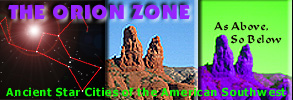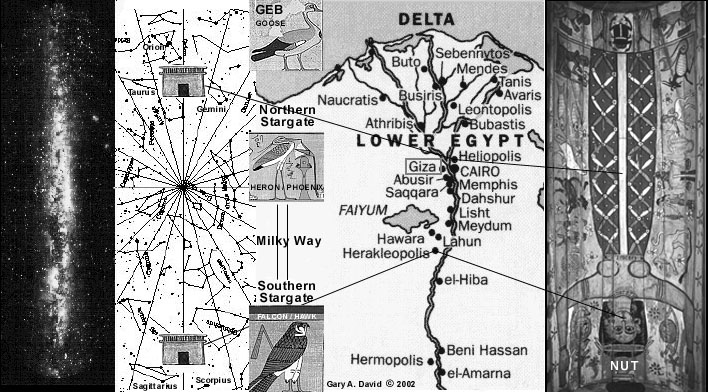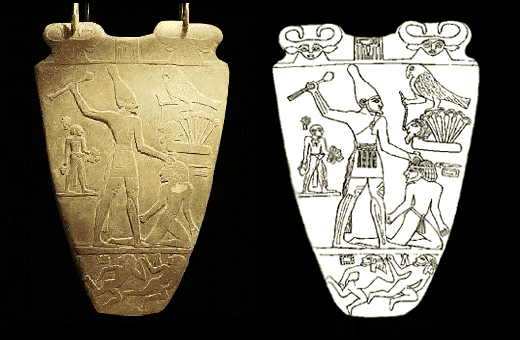In the
current development of Western civilization, the popular imagination has
seized with a
peculiar ferocity upon the notion of the stargate as a sort of cosmic corridor
leading to a whole
new world or a dimension radically different from ours. The cult classics
Stargate and Contact as
well as astrophysicists’ theories about wormholes --a household word
in the wake of Star Trek
and its ilk-- invest such ideas with an almost mythical potency. This phenomenon
is not new but
may instead have accompanied human beings’ first realization of their
own individual mortality.
Even if Near Death Experiences may not have been common in our evolutionary
history, they
were certainly not unknown either. NDEs could have correlated the long tunnel
which takes us to
brilliant white light of the afterlife and the birth canal which brings
us into this life. Both may be
considered as forms of stargates-- the soul’s passageway to and from
the celestial realm.
 The Book
of the Dead, an ancient Egyptian manual of resurrection technology,
identifies
The Book
of the Dead, an ancient Egyptian manual of resurrection technology,
identifies
both the falcon and the heron/phoenix as key icons, each of which is apparently
associated with aspecific directional portal or doorway in the sky. In Spell
13, the Spell for going in and out of the West (symbolic of the Underworld),
the afterlife journeyer states: “I have gone in as a falcon, I have
come out as a phoenix...”1
The former bird corresponds to the southern stargate of what may
be termed “ex-carnation,” (“..gone in...” to the Underworld),
providing a conduit for the soul to
 leave the
body after death. The latter bird corresponds to the northern stargate of
incarnation
leave the
body after death. The latter bird corresponds to the northern stargate of
incarnation
(“...come out...” to the Earth), allowing the soul to return to
a new body. The northern stargate is now located between the constellations
Gemini and Taurus. Due to precessional shifting, this
region of the sky was formerly known as the Gate of Cancer. The southern
stargate located at the opposite end of the Milky Way between the constellations
Sagittarius and Scorpio was likewise known as the Gate of Capricorn.2
We currently know that this latter region of the sky points to the center
of our galaxy, where scientists believe a mysterious black hole lies hidden.
In the Spell for being transformed into a divine falcon, the Messenger
addresses Osiris:
“O Lord of the Soul, greatly majestic, see, I have come, the Netherworld
has been opened for me,
the roads in the sky and on earth have been opened for me, and there was
none who thwarted
me.”3 In the same manner
the Spell for being transformed into a heron states: “I am vindicated
on earth, and the terror of me is in the sky -- and vice versa; it is my
strength which makes me
victorious to the height of the sky, I am held in respect to the breadth
of the sky, my strides are
towards the towns of the Silent Land [the realm of the dead].”4
Spell 17 proclaims: “I am that
great phoenix which is in Heliopolis [in Lower Egypt to the north], the
supervisor of what
exists... I go on the road which I know in front of the Island of the Just.
What is it? It is Rosetjau
[or Rostau, the Netherworld]. The southern gate is in Naref [the necropolis
at Heracleopolis, near
the Faiyum, or the lake and marshy area west of the Nile in Middle Egypt],
the northern gate is in
the Mound of Osiris [Heliopolis]; as for the Island of the Just, it is Abydos
[Upper Egypt far to
the south].”5
The oasis of the Faiyum was probably the naturalistic origin of the concept
of the Field of
Rushes, or Field of Reeds, a sort of Egyptian Elysian Fields. Some of the
vignettes for this region
in The Book of the Dead depict the Heron of Plenty perched upon a
small pyramid. It is
interesting to note that the hieroglyph of a heron upon a pyramid corresponds
to the word bah,
meaning “to flood, to inundate.”6
Also shown is a celestial bark containing a staircase (rather like
half of a stepped pyramid cut vertically), which connotes transcendence.
Commenting on
Egyptian funerary literature, the renowned scholar Zecharia Sitchin writes:
“The pictorial
depictions which accompanied the hieroglyphic texts surprisingly showed
the Stream of Osiris as
meandering its way from an agricultural area, though a chain of mountains,
to where the stream
divides into tributaries. There, watched over by the legendary Phoenix birds,
the Stairway to
Heaven was situated; there, the Celestial Boat of Ra was depicted as
sitting atop a mountain, or
rising heavenward upon streams of fire.”7
In papyrus illustrations of The Field of Rushes we also
find either the falcon or a small, human-headed bird representing the ba
(homonym of bah), or
soul, perched atop a pylon, which is a massive rectangular gateway to a
temple or hypostyle hall.8
Thus, the pylon is a perfect symbol for the stargate. In addition, the walls
of the Field of Rushes
are made of iron, presumably meteoric iron, which further stresses its supernal
connotation.9
Egypt
is known as the Two Lands: Lower Egypt and Upper Egypt. Following the
Hermetic maxim “As above, so below,” these correspond to the northern
and southern stargates
respectively, located along the celestial Nile River, i.e., the Milky Way.
“The Milky Way will not
reject me, the rebels will not have power over me, I shall not be turned
away from your portals,
the doors shall not be closed against me...”10
In addition, Spell 109 asserts: “I know the northern
gate of the sky; its south is in the Lake of Waterfowl, its north in is
the Waters of Geese...”11
In
other words, the northern gate’s southern limit is where the
heron’s domain begins, which is
probably a reference to the Faiyum, while the northern gate’s northern
limit is symbolically
inhabited by geese. The goose is frequently equated with Geb (sometimes
written Seb or Keb),
the god of Earth and husband of Nut, who is the personification of the sky.
Geb’s chief seat is in
Heliopolis to the north where with his wife he produced the great Egg whence
sprang the sun god
in the form of the phoenix.12
“The doors of the sky are opened for me, the doors of the earth are
opened for me, the door-bolts of Geb are opened for me, the shutters of
the sky windows are
thrown open for me. It is he who guarded me who releases me, who binds his
hand on me and
thrusts his hand on to me on earth, the mouth of the Pelican is thrown open
for me, the mouth of
the Pelican is given to me, and I go out into the day to the place where
I desire to be.”13
Significantly, the pelican is related to the phoenix in alchemical literature,
and both are
associated with the color red. Perhaps it is not coincidence, then, that
the Red Crown (Deshret)
comes from Lower Egypt, whereas the White Crown (Hedjet) is from Upper Egypt.
The two
lands (i.e., Crowns) were united when King Menes of Hierakonpolis (about
forty-five miles
south of Thebes) conquered the Delta circa 3100 B.C.14
As an anthropomorphism of the sky, Geb’s wife Nut is conceptualized
as arching face
down over her supine husband, who is sometimes portrayed in an ithyphallic
manner. Her fingers
and toes form the horizon, while stars glisten like semen on her dusky belly.
Both figures are
positioned in the same direction, though some confusion exists about exactly
which direction
they are oriented. Although the couple is sometimes seen with their heads
pointing toward the
west, it makes more sense that the torso of Nut would represent the north-south
orientation of the
Milky Way/Nile as seen during the pre-dawn and post-dusk periods of the
vernal and autumnal
equinoxes. If we accept this positioning, her four outstretched limbs could
represent the sunrise
and sunset solstice points on the horizon, while her vagina could signify
the northern stargate and
her mouth the southern stargate. In this case, her head would be pointed
south (similar to the
Orion Correlation at Giza). Egyptian lore recounts that when the Milky Way
hugs the northern
horizon, arching from east to west during the pre-dawn winter solstice,
Nut comes down to Earth
to lie with her husband Geb.
In his provocative book Signs In the Sky Adrian Gilbert compares
the constellation Orion
with the biblical Jacob and the Milky Way with his ladder (Genesis 28:12).15
Indeed, the Egyptian
“bible” contains similar passages. The psychologist C.G. Jung
observes:
“In
one of the Pyramid Texts he [viz., Set, brother of Osiris] and Heru-ur (the
‘older Horus’) help Osiris [Orion] to climb up to heaven. The
floor of heaven
consists of an iron plate, which in places is so close to the tops of the
mountains
that one can climb up to heaven with the help of a ladder. The four corners
of the
iron plate rest upon four pillars, corresponding to the four cardinal points.
In the
Pyramid Texts of Pepi I, a song of praise is addressed to the ‘ladder
of the twin
gods,’ and the Unas text says: ‘Unas cometh forth upon the Ladder
which his
father Ra hath made for him, and Horus and Set take the hand of Unas, and
they
lead him into the Tuat [or Duat, the Underworld].’”16
1.
The Ancient Egyptian Book of the Dead, translated by Raymond O. Faulkner
(Austin:
University of Texas Press), 1990, 1985, 1972), p. 37.
2. Giorgio de Santillana and Hertha von Deschend, Hamlet’s Mill: An
Essay Investigating the
Origins of Human Knowledge and Its Transmission Through Myth (Boston:
David R. Godine,
Publisher, Inc., 1998, 1969), p. 242.
3. Spell 78, The Book of the Dead, op. cit., pp. 77-78.
4. Spell 84, Ibid., pp. 81-82.
5. Ibid., pp. 44-45.
6. Sir. E.A. Wallis Budge, Egyptian Language: Easy Lessons in Egyptian
Hieroglyphics (New
York: Dover Publications, Inc., 1983, 1966, 1910, 1889), p. 66.
7. Zecharia Sitchin, Stairway to Heaven: Book II of the Earth Chronicles
(New York: Avon
Books, 1983, 1980), p. 50.
8. Faulkner, The Book of the Dead, op. cit., p. 105, p. 106, p. 110.
9. Ibid., p. 102.
10. Spell 72, Ibid., p. 72.
11. Ibid., p.102.
12. E.A. Wallis Budge, The Gods of the Egyptians, Vol. II (New York:
Dover Publications, Inc.,
1969, 1904), pp. 94-96.
13. Faulkner, Spell 68, The Book of the Dead, op. cit., p. 69.
14. Evelyn Rossiter, The Book of the Dead: Papyri of Ani, Hunefer, Anhaï
(London: Miller
Graphics/Crown Publishers, Inc., 1979, 1978), p. 21.
15. Adrian Gilbert, Signs in the Sky (London: Bantam Books, 2000),
pp. 202-205.
16. C.G. Jung, Aion: Researches Into the Phenomenology of the Self,
translated by R.F.C. Hull
(Princeton, New Jersey: Princeton University Press/Bollingen Series XX, 1979,
1978, 1968,
1959), p. 122.
17. Ibid., p. 124.
18. Faulkner, Spell 98, The Book of the Dead, op. cit., p. 89.
19. Spell 23, Ibid., p. 52-53.
20. Spell 69, Ibid., pp. 70-71.
21. Spell 180, Ibid., p. 177.
22. a. “The Narmer Plate and Osiris, the Lord of Precession,” Ancient
Egyptians and the
Constellations: Part 9, Audrey Fletcher, 1999 [web site online]; available
from the World Wide
Web, <http://ancientegypt.hypermart.net/osirisprecession/index.htm>;
accessed 28 January 2002;
b. “Narmer and the Early Egyptian State,” Per Medjat, Zoe Jackson
[web site online]; available
from the World Wide Web,
<http://www.geocities.com/per_medjat/narmer_egyptian_state.html>; accessed
28 January 2002.;
c. “The Narmer Palette: The victorious king of the south,” An introduction
to the history and
culture of Pharaonic Egypt [web site online]; available from the World Wide
Web,
<http://nefertiti.iwebland.com/narmer/index.html>; accessed 28 January
2002.
23. Re, “form of the sun god at his noon-day strength, often falcon-headed,”
Faulkner, The Book
of the Dead, op. cit., p.192.
24. Spell 180, Ibid., p. 180.
25. a. Richard Hinckley Allen, Star Names: Their Lore and Meaning (New
York: Dover
Publications, Inc. 1963, reprint 1899) p. 308; b. Francis Huxley, The Way
of the Sacred: The
Rites and Symbols, Beliefs and Tabus, That Men Have Held in Awe and Wonder
Through the
Ages (New York: Dell Publishing Co., Inc., Laurel Edition, 1976, reprint
1974), p. 212.
26. Jung, Aion, op. cit., p. 65n.
27. Rossiter, The Book of the Dead, op. cit., p. 21.


 The Book
of the Dead, an ancient Egyptian manual of resurrection technology,
identifies
The Book
of the Dead, an ancient Egyptian manual of resurrection technology,
identifies leave the
body after death. The latter bird corresponds to the northern stargate of
incarnation
leave the
body after death. The latter bird corresponds to the northern stargate of
incarnation
